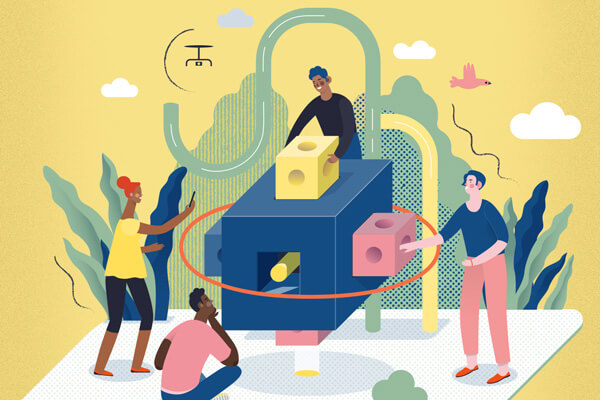
Creating an inclusive syllabus
Meeting students where they live by considering equity, diversity and inclusion
Often compared to a course contract between instructors and students, syllabi are necessary classroom tools. They set out expectations for teacher and student, providing learners with key information about reading lists, course calendars, assignments, exams and deadlines.
But they can be much more.
At the University of Manitoba, syllabi are increasingly meeting students where they live by bringing equity, diversity and inclusion (EDI) to these introduction-to-the-course documents. Teachers are including flexibility around assignments, as well as opportunities for student reflection and input.
“A theme that emerges time and again at teaching and learning centres is that instructors really set the tone for inclusion in their course through the syllabus,” says Robin Attas, educational developer, equity, diversity, inclusion (EDI) in the Centre for the Advancement of Teaching and Learning (CATL).
Inclusion is not created via a checklist but there are common elements instructors can flag during the process of creating syllabi, says Attas. For example, is there diversity among the authors on a reading list? Is there a land acknowledgment in the document and is this statement deepened through additional course design and implementation elements? Does the syllabus focus on the instructor making the rules, or does it invite students to be part of the conversation?
Being open to student contributions around issues like what grade weight is given to assignments, inviting them to choose some of the course content, or showing flexibility around deadlines to acknowledge pressures and responsibilities outside the classroom demonstrates the instructor cares about them and wants to meet their needs as individuals.
Attas says inclusive syllabi help students feel like they matter and that can have positive effects on learner outcomes. Research shows students who feel they matter as individuals have better rates of retention.
To help UM faculty create more inclusive syllabi, Attas and her CATL colleagues are facilitating a workshop on developing an inclusive syllabus on Aug. 17. Participants will meet in small groups to get input on one of their syllabi-in-progress “with a focus on inclusive, anti-racist and decolonial principles that are beyond-compliant with UM’s Responsibilities of Academic Staff with Regard to Students (ROASS) requirements.”
CATL also has a project in the works, planned to launch in August, to create a new web resource for instructors to aid in creating inclusive syllabi. Their website also has a wide range of information on EDI strategies, resources and readings.
Some UM instructors have been writing inclusive syllabi for years.
Rebecca Simpson-Litke, assistant professor, music theory at the Desautels Faculty of Music has been creating inclusive syllabi since she was in grad school.
“These are practices that I’ve adopted for many years,” she says. “I’m thinking more and more, as we all are, who is in our classroom?”
“I’m thinking more and more, as we all are, who is in our classroom?”
Simpson-Litke is interested in getting people from all backgrounds into music study, as opposed to what she calls the select and privileged few. An inclusive syllabus can play a role in making students feel they belong in the class, she says.
In the syllabus for her first-year required course in music theory, Simpson-Litke lets her students know that all repertoire is worthy of study and that she encourages and values their suggestions.
“I put that on the first page of the syllabus. I’m excited about the music you’re excited about,” she says.
She also makes it clear she’s flexible about assignments and workload.
“I always have a clause that says if this is difficult for you, talk to me, please,” says Simpson-Litke. “I’ve never felt that students have taken advantage of that in a way that’s inappropriate.”
Simpson-Litke understands why a strict syllabus can appeal to new teachers. It creates boundaries between student and professor and establishes authority.
“It’s okay to show that you care about the students,” she points out. “That doesn’t mean that you’re not strict, that you don’t have high standards.”
“It’s okay to show that you care about the students. That doesn’t mean that you’re not strict, that you don’t have high standards.”
Randy Herrmann is director of the Engineering Access Program (ENGAP) at the Price Faculty of Engineering, which assists Indigenous students succeed in Engineering. He says since he trained as an engineer, not a teacher, he never learned the academic method of writing syllabi. His starting point is what do his students need to know?
For his preparatory physics 1 and preparatory physics 2 non-credit upgrading classes for ENGAP students, his syllabi are sprinkled with humour to explain expectations and deadlines. A cartoon Einstein points to important information. A “this is super-duper important” sticker flags the study topics list.
He also goes over the syllabus with students, having them take turns reading sections aloud and asking them how they’re interpreting each passage.
In January, Herrmann began teaching a new class with assistant professor Jillian Seniuk Cicek offered to all Price Faculty of Engineering students — Decolonizing and Indigenizing Engineering. It’s the first of its kind in Canada.
The course syllabus, prepared by Seniuk Cicek, has an inspiring and welcoming tone and was introduced to students in the first class in a colourful slideshow format. It begins with a land acknowledgement and encourages discussion and reflection, as well as including information on supports for learners.
The syllabus lets students know they are required to hand in a weekly critical reflection on what they experienced and learned in class. Herrmann and Seniuk Cicek put no restrictions on how students submitted the weekly assignment to encourage student choice and to respect Indigenous pedagogies and ways of knowing and sharing knowledges. Students could choose to submit a written response or an audio/visual recording of their critical reflection, or any other medium, making room for multi-model forms of expression and knowledges. “If you want to do it in interpretive dance, that’s okay,” Herrmann told them.
A less-rigid approach to syllabi is the goal, Herrmann says, as it also supports engineering practice.
After all, Herrmann says, whether in creating a syllabus or in the real world of engineering design, flexibility pays off.
For more information on inclusive syllabi, including web resources, workshops or individual consultation, visit the Centre for the Advancement of Teaching and Learning’s website, or email thecentrecontactus@umanitoba.ca.
TeachingLIFE
UM is a place where we prioritize an inclusive learning and innovative teaching environment, in order to foster a truly transformative educational experience. TeachingLIFE tells the stories of our ground-breaking educators and their impact on student success.
Learn moreOther TeachingLIFE articles

Difficult conversations in the classroom
Confronting controversy to lead to a less-polarized society

Learning from the stars, and our backyards
Experiential learning is more than career preparation, it’s life preparation
More from TeachingLIFE
About CATL
The Centre for the Advancement of Teaching and Learning is an academic support unit that provides leadership and expertise in furthering the mission of teaching and learning at the University of Manitoba.
Learn more about CATL











